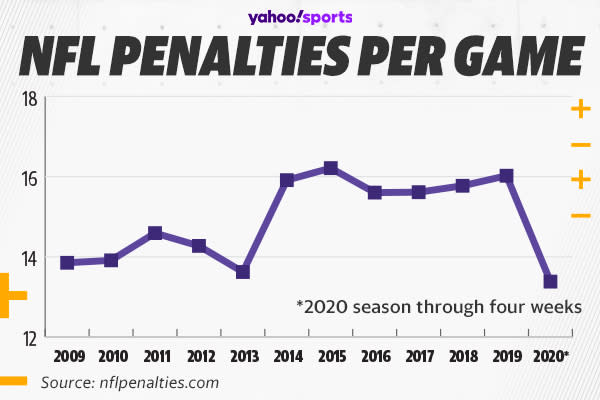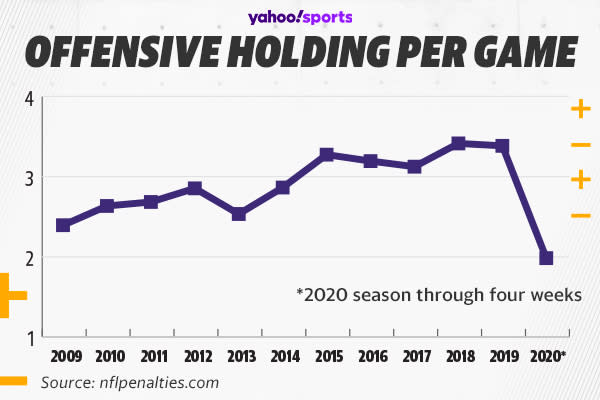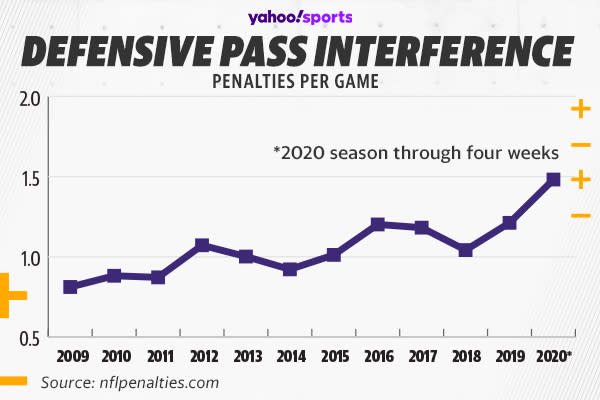NFL scoring is on a historic pace. Thank the refs
Pick a stat. Any stat. Take Dak Prescott’s 1,690 passing yards, which are on pace to smash Peyton Manning’s single-season mark. Or the Green Bay Packers’ 38 points per game, which would be the most ever. Or the entire NFL. Through four weeks, teams are averaging 25.7 points — over two more than the 72-year-old league record.
NFL offenses have been accelerating for a while now. Rule changes, prolific quarterbacks and innovation have been their catalysts. But this? This is an explosion.
And one primary source?
Referees.
NFL officials are throwing flags at decade-low rates. They’re calling offensive holding less than in any of the previous 25 seasons. And as former NFL VP of officiating Dean Blandino told Yahoo Sports: “Offensive linemen didn't stop holding. … It's still happening as much as it happened in the past.”
But refs aren’t whistling. Through four weeks, they’ve flagged 127 offensive holding penalties, a 56% year-over-year decrease. They’ve called fewer in four weeks this year than they did through two weeks in 2019.
The leniency lends to more points — and to exciting, watchable football. The question, though, is how long it can last.
“We are really changing the game,” Blandino says. “And it feels like we're changing it almost on the fly. And that's what you worry about.”

The penalty plunge
The trend, it’s clear, is the byproduct of a league directive.
"When we were preparing [for the season], we had a theme of 'clear and obvious' and we wanted that to continue throughout the year," NFL senior VP of officiating training and development Walt Anderson said last month. In other words, refs have been told to call the blatant penalty, and ignore the “ticky-tack” one.
But that, Blandino says, has always been the instruction to some extent. This year’s penalty plunge is “significant,” if not unprecedented.
Through four weeks, refs are throwing 13.38 flags per game. That’s down from 18.48 over the first four weeks of last season, when there was an emphasis on stricter enforcement. Full-season averages over the previous five years were 16.02, 15.77, 15.61, 15.60 and 16.21.

And the new emphases have specifically benefited offenses. Refs have called 2.02 offensive holding penalties per game, down from 4.54 over the analogous period last season. Full-season averages over the previous five years were 3.42, 3.45, 3.16, 3.23 and 3.31.

Meanwhile, those same refs have called 1.48 defensive pass interference penalties per game, far more than in any full season dating back to at least 2009. If that rate continues through 17 weeks, it would likely be the highest ever.

The sample size remains small. But the imbalance, as long as it continues, will help offense flourish. Holds create space for running backs and quarterbacks. When they go uncalled, they don’t bury drives.
Are fewer penalties actually bad?
The trend, in the immediate term, boosts the sport. Penalties are bad. Uninterrupted action, shorter games and more points are good. So what’s the problem?
“One of the concerns is, when you're not calling holding, now [coaches] are gonna coach it,” Blandino explains. “And now [players] are going to take advantage of that. Which I know teams are doing. They talk about it ... when they're in the offensive line room. Because if [refs] are not gonna call it, then let's push the envelope and see how far we can go with it.”
No matter where refs set the threshold, players will test its limits. They’ll realize they can get away with more. They’ll hold more. And refs will have a decision. One option will be to return to the norm, and call penalties as much as they used to. (Blandino expects this.) The other will be to allow previously illegal play to run rampant.
That, some might argue, still wouldn’t harm the game. Offenses would keep exploding. Offensive explosions, to most fans, sound fun. But balance is necessary, Blandino explains, because the mere concept of an offensive explosion — of a high-scoring game — is relative.
“Everyone loves a high-scoring game once in a while, but if that becomes the norm, it loses its luster,” he says. If every game were in the 40s or 50s, that memorable Chiefs-Rams Monday nighter in 2018 “would've been just another game.”
NFL team scoring has risen progressively over the past 30 years, from 20 points per game in the 1990s to around 21 in the 2000s to over 22 last decade. The growth has been steady and the inflation rate healthy — as long as the NFL’s newfound leniency doesn’t let it get out of control.
More from Yahoo Sports:

 Yahoo Finance
Yahoo Finance 
